九年级英语unit 7教案
- 格式:doc
- 大小:38.50 KB
- 文档页数:4
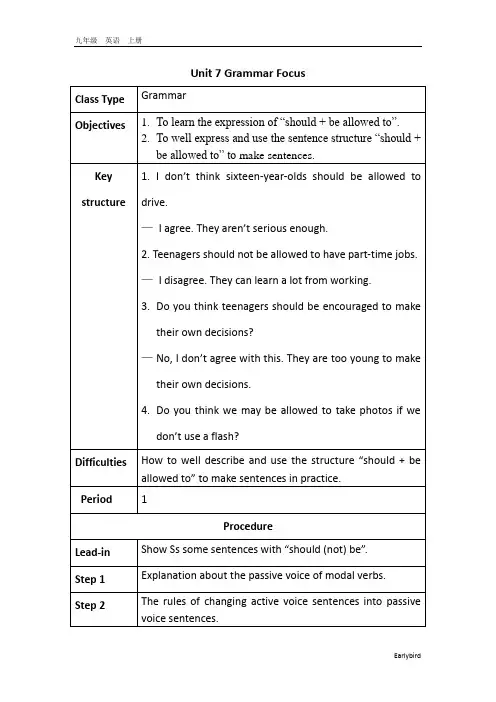
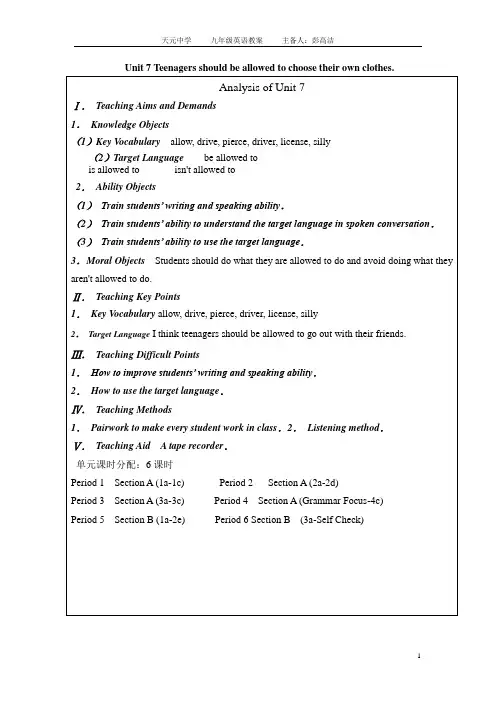

Unit 7 Teenagers should be allowed to choose their own clothes.Section B 2a-2b 教学设计教学目标:1.会读会写下列词汇:support, enter, choice. 能理解运用下列短语:get in the way of.2.能听懂接近自然语速的故事和叙述,整体感知,了解文章大意。
3.能用简单的阅读策略获取信息,理解文章并完成阅读任务。
4.巩固学习should/should not be allowed to do的被动语态,勇于发表自己的观点和意见,懂得听取有益的建议。
教学重点:1.根据上下文理解重点单词和词组的意思。
2.能用简单的阅读策略获取信息,理解文章并完成阅读任务。
教学难点:在理解文章的基础上,巩固学习含情态动词的被动语态,并学会运用和拓展。
教具准备:多媒体教学过程:Step1.Warm-up and lead inUse a small toy to cheer up and have a free talk according to 2a.Step2.Show the study aims.Step3.Self-study1.Listen to the tape and finish:task1:Underline the new words and phrase in the passage and guess their meanings:get in the way of,support, enter, choice.task2:What’s the main idea of the passage?(After listening,teach the new words again and ask the question.)2.Skim the passage and circle T or F.3.Read carefully and fill in the chart.Step4.C ooperation & Competition1.Find out the sentences which including ‘shoul d be allowed to' in the passage.2.Write your own sentences with ‘should/should not be allowed to do’ on your grouppaper ,as many as you can,and have a competition with other groups.Step5.Summary and enjoy a songShould you be allowed to make all the decisions by yourselves?Step6.Practice1.Do a match.2.Choose the right answer.Step7.Homework1.Remember the new words and phrases in this lesson.2.Read the passage aloud after class.3.Finish the exercise book and prepare next period.Step8.Listen to the song “Be What You Wanna Be”.。
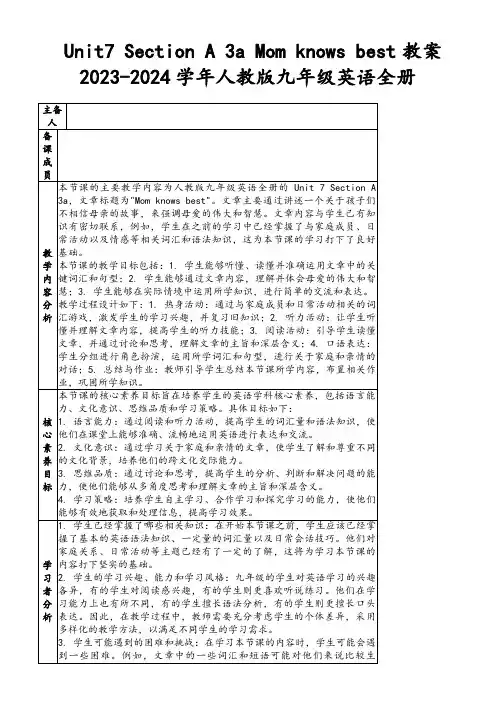

北师大版英语九年级Unit 7 Journeys Communication Workshop 教学设计一. 教材分析北师大版英语九年级Unit 7 Journeys Communication Workshop的主题是关于旅行的。
本节课的主要内容是描述旅行的计划和经历。
通过本节课的学习,学生能够掌握有关旅行的话题词汇,学会如何用英语描述旅行的计划和经历,提高学生的英语口语表达能力。
二. 学情分析九年级的学生已经具备了一定的英语基础,能够理解和运用一些基本的英语句型和词汇。
但是,对于一些关于旅行的专业词汇和表达方式,学生可能还不够熟悉。
此外,学生可能对于如何描述自己的旅行经历还存在一定的困难。
因此,在教学过程中,需要帮助学生扩充旅行相关的话题词汇,并提供足够的实践机会,让学生能够运用所学知识进行实际交流。
三. 教学目标1.知识目标:学生能够掌握关于旅行的相关词汇和表达方式,如“旅行计划”,“旅行经历”,“旅行目的地”等。
2.能力目标:学生能够用英语描述自己的旅行计划和经历,提高学生的英语口语表达能力。
3.情感目标:通过本节课的学习,学生能够激发对旅行的兴趣,增强对不同文化背景的了解和尊重。
四. 教学重难点1.重点:学生能够掌握关于旅行的相关词汇和表达方式。
2.难点:学生能够用英语描述自己的旅行计划和经历。
五. 教学方法1.任务型教学法:通过设定各种与旅行相关的任务,激发学生的学习兴趣,提高学生的英语口语表达能力。
2.交际法:通过模拟真实的旅行场景,让学生在实际交流中掌握旅行相关词汇和表达方式。
3.小组合作学习:通过小组讨论和分享,促进学生之间的互动,提高学生的合作能力。
六. 教学准备1.教学材料:教材、多媒体课件、旅行相关图片和视频。
2.教学设备:投影仪、计算机、音响设备。
七. 教学过程1.导入(5分钟)通过向学生展示一些旅行相关的图片和视频,引发学生对旅行的兴趣,并引导学生思考他们最喜欢的旅行目的地和经历。

Unit 7 Teenagers should be allowed to choose their own clothes.The First Period Section A 1a–2cTeaching aims(教学目标)口、笔头掌握句型1. A: I don’t think sixteen-year-olds should be allowed to drive.B: I agree. They aren’t serious enough at that age.2. A: Do you think teenagers should be allowed to choose their own clothes?B: Yes, I do. / No, I don’t.13. Sixteen-year-olds should be allowed to get their ears pierced.4. He should stop wearing that silly earring.5. Students must not be allowed to have part-time jobs.熟练掌握词汇:smoke, license, safety. 了解下列词汇:pierce, earring技能目标:能用should/should not be allowed to do谈论应该被允许和不应该被允许做的事情。
情感态度:勇于发表自己的观点和意见,表达同意或不同意。
Difficulties(难点):be (not) allowed to doTeaching steps(教学步骤)21. Warm-up and revision(课堂热身)Show pictures of “Where are dads going?”Kid: Can I drive my friends to the mall?Dad: No, you are not allowed to drive.教学设计说明: 通过情景对话复习情态动词can并且引进新知be( not) allowed to2. Presentation(呈现新知识)呈现王磊和多多的对话练习句型结构3A:Teenagers should not be allowed to smokeB: I agree.教学设计说明:操练句型结构3. Work on 1a.T: Read the statements below. Circle A for agree or D for disagree.1. Teenagers should not be allowed to smoke.2. Sixteen-year-olds should be allowed to drive.3. Students should not be allowed to have part-time jobs.4. Sixteen-year-olds should be allowed to get their ears pierced.45. Teenagers should be allowed to choose their own clothes.4. Work on 1b.T: Listen and circle T for true or F for false.•Anna can go to the shopping center by bus.•Anna wants to get her ears pierced.•Anna wants to choose her own clothes.T:Listen again and complete the conversation.• A. be allowed to choose their own clothes• B. shouldn’t be allowed to get their ears pierced5• C. should be allowed to driveAnna: Mom, can I go to the shopping center with John? He just got his driver’s license. Mom: No way! I don’t think sixteen-year-olds ___________. I’m worried about your safety. Anna: But Gaby’s getting her ears pierced at the shopping center and I want to watch. Mom: Sixteen-year-olds __________________ either. They’re too young.Anna: I agree, but it’s fun to watch. Can I take the bus then?Mom: Well, OK.Anna: Great! I want to buy a new skirt, too.Mom: What kind of skirt? Maybe I should go with you.6Anna: Aww, Mom. I’m not a child. I think teenagers ____________________.Mom: Well, I just want to make sure you get something nice.观察与思考:请观察听力原文中的填写句子。
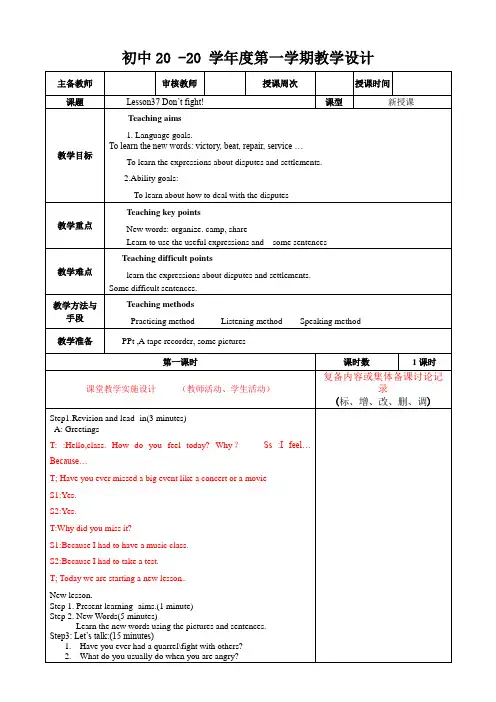

自主学习方案1.学生自学生词,并记住单词拼写和拼读。
2.预习课本,找出重点短语和句式。
(见学案中预习检测的内容)3.读记后完成预习检测作业。
Step 1 复习检查上一课时课后提升作业。
Step 2 情景导入Teacher: Could you tell me what students should be allowed to do or shouldn’t be allowed to do?Students:1.Students should be allowed to have part time jobs.2.Students shouldn’t be allowed to get their ears pierced…环节说明:通过课前师生互动,让学生感兴趣,调动他们的积极性,同时“be allowed to do sth.”的应用,为学习新课埋下了伏笔。
Step 3 完成教材1a~1c教学任务1.要求学生阅读1a部分的内容后自己判断。
2.检查答案。
参考案例:Teacher: I don’t think students should be allowed to go to Net Bar. Students: I agree.3.要求学生听第一遍录音,完成1b的听力任务。
4.要求学生听第二遍录音,并逐句进行跟读。
5.完成教材1c的任务,要求学生根据1a中的陈述,编写对话,进行练习。
6.听力内容巩固训练。
要求学生根据所听到的内容完成下列问题。
(1)根据所听到的内容回答问题。
What is the relationship of the two speakers?(2)再听,完成填空。
The woman doesn’t think sixteen year olds should be allowed to because they aren’t enough. Anna thinks teenagers should be allowed to because she is not a child.答案:(1)Mother and daughter.(2)drive, serious, choose their own clothes环节说明:将听、说、读、写的任务结合起来,不仅锻炼了学生的语言综合运用能力,还巩固了学生对目标语言的学习、识记和运用。

Unit 7 Teenagers should be allowed tochoose their own clothes.教学目标:1语言目标:理解并正确运用本单元的重点词汇2 技能目标:熟练运用“should (not) be allowed to do”谈论应该被允许和不应该被允许做某事;熟练运用“be (not) allowed to do”谈论被允许和不被允许做某事;熟练运用“I agree / disagree.”或“I don’t agree.”表达自己的观点。
3 情感目标:通过了解和反思自己的言行举止是否符合中学生日常行为准则、规范自己的言行,养成自觉遵守规则的良好习惯和优良品德;正确看待“家规”“班规”“校规”等,并能认真遵守;明白父母、教师的合理建议对自己成长的重要性4文化意识目标:了解中外审美观的差异,形成自己的审美观,展示个性;了解中西方关于青少年的不同文明准则。
教学重点:重点语法:被动语态重点词汇:smoke, pierce, license, safety, earring, cry, field, hug, lift, awful, teen, regret, poem, bedroom , community, chance, manage, society, unit, educate, professional, enter, support talk about, keep away from, make one’s own decision, get in the way of重点句型:I don’t think sixteen-year-olds should be allowed to drive.I agree./ I disagree. I think sixteen is too young.Do you think teenagers should be allowed to work at night?Yes, I do. / No, I don’t.教学难点:含情态动词should的被动语态结构“should be allowed to”课时划分:Period One: Section A 1 (1a-2d)Period Two: Section A 2 (3a-3c)Period Three: Section A 3 (Grammar Focus-4c)Period Four: Section B 1 (1a-2e)Period Five: Section B 2 (3a-Self Check)Section A 1 (1a-2d)I. PresentationAsk students: Do your parents allow you to watch TV? Yes, they do.Present the sentence: You are allowed to watch TV.Teach “allow sb to do sth ““be (not) allowed to do sth”“should (not)be allowed to do sth”Present more sentence.Do your parents allow you to exercise?Yes, they do.You are allowed to exercise.Do your parents allow you to smoke?No, they don’t.You are not allowed to smoke.Do your parents allow you to drive?No, they don’t.You are not allowed to drive.Do your parents allow you to choose your own clothes?No, they don’t.You should be allowed to choose your own clothes.Do your parents allow you to get your ear pierced?No, they don’t.You should not be allowed to get your ear pierced.II. Warming upObey the school rules!As a teenager, you have a lot of rules at school. Can you write down some of them? Students should be allowed to speak English loudly.Students shouldn’t be allowed to sleep in class.Students shouldn’t be allowed to make noises.Students shouldn’t be allowed to throw the rubbish in the classroom. Students shouldn’t be allowed to get to class late.Explain:allow sb to do sth允许某人做某事be allowed to do sth被允许做某事should be allowed to do sth应该被允许做某事1a. Read the statements below. Circle A for agree or D for disagree.1. Teenagers should not be allowed to smoke. A D2. Sixteen-year-olds should be allowed to drive. A D3. Students should not be allowed to have part-time jobs. A D4. Sixteen-year-olds should be allowed to get their ears pierced. A D5. Teenagers should be allowed to choose their own clothes. A D III. Listening1b Listen and circle T for true or F for false.1. Anna can go to the shopping center by bus. T F2. Anna wants to get her ears pierced. T F3. Anna wants to choose her own clothes. T FIV. Practice1c Look at the statements in la and make conversations.A: I don't think sixteen-year-olds should be allowed to drive.B: I agree. They aren't serious enough.V. Key phrases1. be allowed to do 被允许去做2. the shopping center 购物中心3. driver’s license 驾驶执照4. sixteen-year-olds 16岁的孩子5. be worried about your safety 担心你们的安全6. part-time jobs 兼职工作7. get their ears pierced 穿他们的耳朵8. their own clothes 他们自己的衣服9. serious enough 足够严肃VI. Listening2a What does Molly think of Kathy’s statements? Listen and circle A for Agree,D for Disagree or DK for Doesn’t Know.2b Listen again. What are Kathy’s and Molly’s reasons? Number their reasons in the correct order._____ It looks cool._____ Young people need to sleep._____ He needs to spend time with friends._____ He needs time to do homework._____ It doesn't look clean.VII. Practice1. 2c Make a list of things teenagers should and should not be allowed to do. Discuss your list with your partner.A: Do you think teenagers should...?B: Yes, I .../No, I...2. 2d Read the conversation and answer the questions.1) Where do they go for school trip?2) Does Mr. Smith allow students to take photos?3) How to take photos?3. Role-play the conversation.VIII. Summary1. Language pointsallow的用法1) Teenagers should be allowed to choose their own clothes.2) Teenagers should not be allowed to smoke.3) It is not allowed in the museum.4) Do you think we may be allowed to take photos if we don't use a flash?以上四句都含有重要的句型be allowed to do sth.,其中第三句是此句型的一般现在时,一二四句是情态动词与此句型的混合使用。
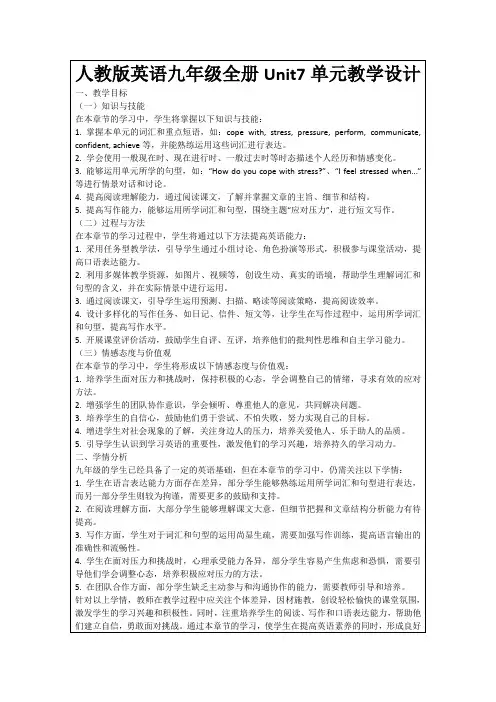

Unit 7 Teenagers should be allowed to choose their own clothes(第1课时)一、教材分析:本节课着重谈论青少年是否被允许做某事及对该事物的评价。
即围绕“Teenagers should(not) be allowed to ------.”这个话题进行讨论的。
其难点是被动语态的运用。
提倡课前预习是我们的一贯做法。
本课把直观式教学注入到任务型教学之中,让学生真正体验到“学中有乐,乐在学中”。
二、三维目标:1.知识和技能目标:1)谈论青少年应该或不应该被允许做什么。
Teenagers should(not) be allowed to ------.2) 了解家规、班规、校规。
2.过程与方法目标:1)能运用所学知识练习被动语态的句式。
2)能用所学句型进行交际练习。
3)提倡课前预习是我们的一贯做法。
本课把直观式教学注入到任务型教学之中,让学生真正体验到“学中有乐,乐在学中”。
3.情感、态度和价值观目标:培养学生的听说演等能力及合作学习的意识。
三、教学重点:围绕“Sb should(not) be allowed to do sth”这个话题,运用所学短语进行讨论。
四、教学难点:被动语态的运用及构成。
五、教学策略:通过谈论家规、班规和校规,充分掌握被动语态的用法.六、教学准备: 多媒体课件教科书卡片录音机课前预习学案。
七、教学环节:Step1 Phrases learningShow these cards in Chinese:go out with friends every night get their ears pierced have part-time jobs drive choose their own clothes work at night do homework with friendsRead after the teacher the phrases .Then read together.Ask the students read the cards one by one.(出示卡片,学习短语; 运用卡片检验学习效果。
Unit 7Teenagers should be allowed to choosetheir own clothes.Section A (3a—3c)一、教学目标1.能熟练掌握下列词汇及短语:tiny, cry, field, hug, lift, badly, awful, regret, poem, talk back, regret doing sth.等。
2. 掌握重点句型:When I was a tiny baby crying all night, my mom sang to me and stayed by my side.When I was two running through the field, she made sure I was safe and kept me from danger. When I fell and hurt myself, she gave me a hug and lifted me up.Now I’m an adult, thinking back to those times.I regret talking back, not listening to Mom.3. 能够读懂有关描绘孩子成长过程中与母亲的互动交流的诗歌,并能够根据文段中的信息完成相应的阅读任务。
4. 能够掌握并运用含有情态动词的被动语态谈论“家规”和“校规”。
5. 能够理解父母对自己的关爱和教导,明白父母、老师的合理建议对自己成长的重要性。
二、教学重点及难点重点:1. 掌握本课时重点词汇、短语和句型表达。
2. 能够阅读有关描绘孩子成长过程中与母亲的互动交流的诗歌。
难点:能够掌握并运用含有情态动词的被动语态谈论“家规”和“校规”。
三、教学准备教师:教学课件;多媒体设备学生:课前预习四、教学过程Step 1 Warming-upFree talkT: Can you describe your mother in one word?S1: …T: What are you not allowed to do by your mother?S2: …【设计意图】通过讨论引出本节课中有关母亲的话题,活跃课堂气氛,让尽可能多的学生动起来,迅速调整到上课状态。
Unit 7 Teenagers should be allowed to choose their own clothesGrade level: 9th GradeCourse: EnglishTextbook: New Standard English, Book 9, published by People's Education Press.Objectives:To introduce students to the topic of freedom of expression and individuality.To help students improve their reading, writing, listening and speaking skills in English.To encourage students to think critically and express their opinions effectively.To enhance students' understanding of cultural differences and the importance of respecting others' perspectives.Materials:Textbook: New Standard English, Book 9, published by People's Education Press.Whiteboard or blackboard and markers.Handouts with comprehension questions related to the reading.Audio or video materials related to the topic.Pictures of different types of clothing and styles.Procedure:I. Warm-up activityThe teacher begins the lesson by asking students about their favorite type of clothing and why they like it.The teacher then asks students if they think it is important for teenagers to be allowed to choose their own clothes.II. Pre-reading activityThe teacher presents some pictures of different types of clothing and styles and asks students to discuss which ones they like and why.The teacher then divides the class into groups and asks them to discuss the pros and cons of having a dress code at school.III. Reading comprehensionThe teacher asks students to read the text "Teenagers Should Be Allowed to Choose Their Own Clothes" from their textbook.The teacher then distributes handouts with comprehension questions related to the reading and asks students to answer them individually.The teacher then discusses the answers with the class.IV. Vocabulary buildingThe teacher asks students to find some new words or phrases from the reading, and to write them on the board.The teacher then asks students to work in pairs and use the new vocabulary words in sentences.V. Listening comprehensionThe teacher plays an audio or video clip related to the topic, and asks students to listen carefully. The teacher then distributes handouts with comprehension questions related to the clip and asks students to answer them.VI. Writing activityThe teacher asks students to write a persuasive essay about why teenagers should be allowed to choose their own clothes.The teacher then asks students to exchange their writing with a partner, and to provide feedback on each other's writing.VII. Follow-up activityThe teacher concludes the lesson by asking students to share their opinions about the importance of freedom of expression and individuality, and how they think this applies to clothing choices.Assessment:The teacher can assess students' performance through the following:Observing their participation in class discussions and group activities.Reviewing their answers to comprehension questions.Assessing their writing activity and providing feedback.Observing their use of new vocabulary words in sentences.Homework assignment for "Teenagers Should Be Allowed to Choose Their Own Clothes" lesson:Write a persuasive essay arguing for or against having a dress code at school.Find a news article or opinion piece about a recent controversy related to clothing and dress codes, and write a summary of the article and your own opinion on the issue.Interview a family member or friend from a different culture about their attitudes towards clothing and fashion, and write a reflection on what you learned.Choose a celebrity or fashion icon and research their style and fashion choices. Write a short biography of the person and discuss their impact on fashion trends.Watch a documentary or video about the history of fashion and write a summary of what you learned.Write a journal entry reflecting on your own personal style and how it reflects your individuality.Practice reading aloud the text "Teenagers Should Be Allowed to Choose Their Own Clothes" from your textbook, paying attention to your pronunciation and intonation.。
《Unit7Youaresupposedtoshakehands》教案《Unit7You are supposed to shake hands》教案一、教材依据山东省教育出版社《义务教育课程标准实验教科书﹒英语》(九年级)为依据,设计的内容是九年级英语课本第七章第一节课You are supposed to shake hands。
二、设计思想根据《英语课程标准》及《英语教学大纲》的要求,在本节课的教学过程中,采用“任务型”的教学途径,借且助多媒体,增强趣味性和直观性,增大课堂容量,提高课堂效率,面向全体同学,让每一个学生都能参与到活动中来,同时,在听说读写协调运用和过程中让学生学会掌握知识、发展能力、陶冶情感、态度、形成正确的价值观。
让学生学会:①、能够描述自己或他人在不同场合应该做什么②、能同他人讨论不同国家的风俗习惯,如初次见面的礼仪、餐桌礼仪等。
③、让学生了解中外文化,避免发生因文化冲突造成的尴尬,同时,弘扬我国优秀的传统文化,提高学生的听、说、读、写的全面能力。
三、教学目标1)Knowledge aims :1.Students can grasp the target language and vocabularies.What are you supposed to do when you meet someone?——You are not supposed to shake hands.——You should have asked what you were supposed to wear?2)Ability aim:(1) Train students’ listening ability.(2) Train students’ integrating skills.(3)Train students’ communicative competence.(4)Improve the four skills of learning English .3)情感目标:培养学生的爱国主义情操,学会比较不同的国家的文化差异。